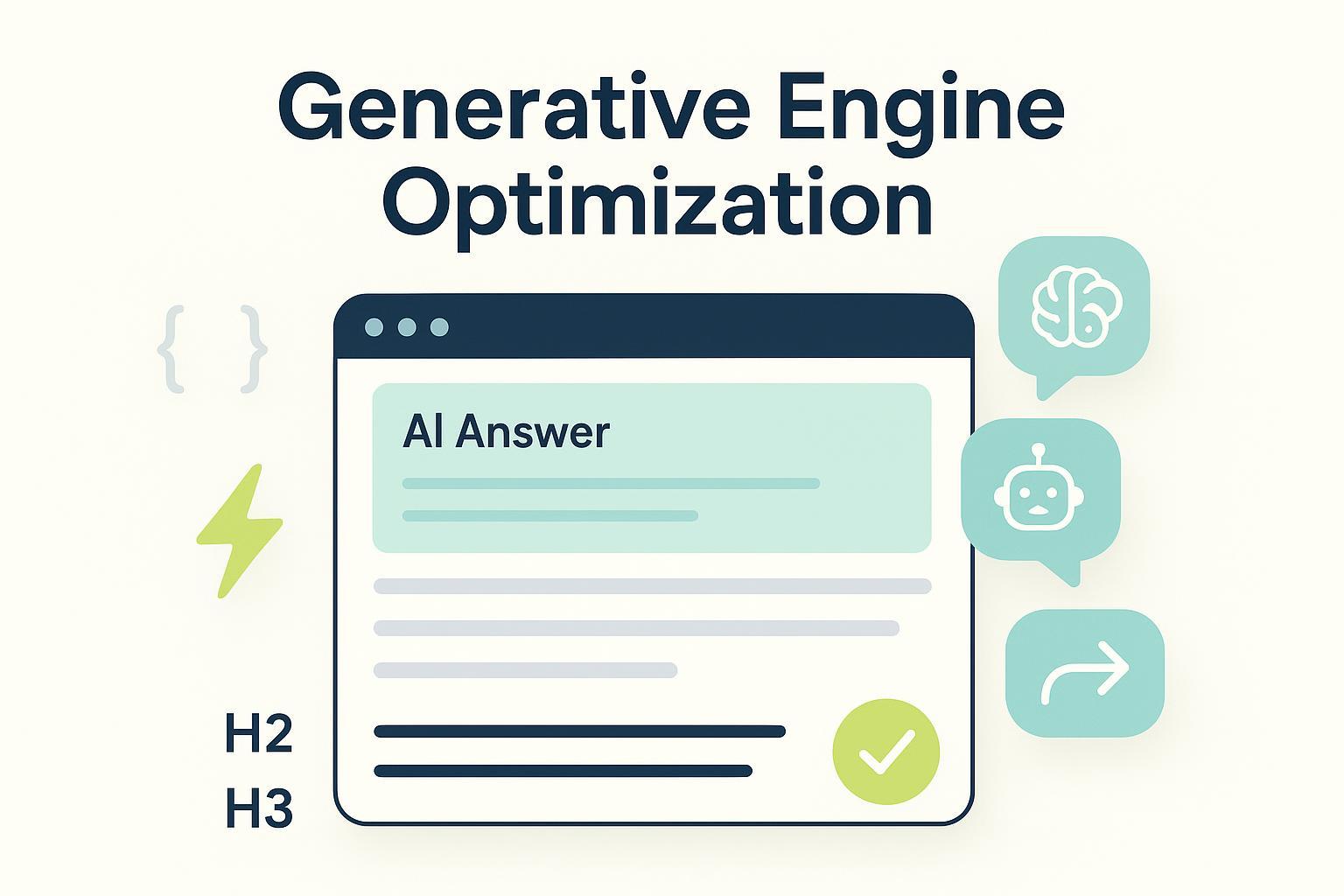How to implement Generative Engine Optimization
Implement Generative Engine Optimization to create AI-friendly content, use structured data, and adapt to search trends for better visibility and engagement.


Generative Engine Optimization (GEO) helps create content for AI tools. Tools like ChatGPT now have over 100 million users each week. GEO is important because it matches how people search today. About 1 in 10 U.S. internet users use AI to ask questions online. This number is growing fast. Businesses using GEO can stand out and get more attention. Geneo makes this easier with smart tips and ideas for better results. It helps you stay ahead in the online world.
Key Takeaways
Generative Engine Optimization (GEO) helps understand what users need. It gives clear answers, making your content easier to find in AI searches.
Adding structured data and schema markup helps AI understand your content. This makes it more likely to show up in search results.
Writing good, timeless content that answers common questions keeps readers interested. This also helps your content rank higher in AI searches.
Updating your content often to match AI trends keeps it useful. This brings more visitors to your website.
Tools like Geneo give helpful tips to improve your content. These tips work for both regular SEO and AI-based platforms.
What is Generative Engine Optimization?
Generative Engine Optimization (GEO) is a new way to improve content for AI tools. Unlike old SEO, which focuses on matching keywords, GEO looks at what people really want. It helps answer questions in a clear and helpful way. This matches how people use AI tools like ChatGPT and Bard. Instead of showing links, these tools give direct answers.
Definition and core principles
GEO is based on three main ideas: knowing what users need, making content trustworthy, and using AI to create helpful answers. Here's how it works:
Knowing user needs helps you solve their problems directly.
Following Google's E-E-A-T rules builds trust and shows expertise.
Using AI tools helps you make content that fits your audience's needs.
Experts say fewer people will use regular search engines by 2026. AI tools will become more popular, so GEO is key to staying visible online.
How GEO aligns with AI-driven search engines
AI tools like ChatGPT and Bard use smart systems to understand and share information. They care more about meaning and context than just matching words. GEO helps by making content clear, organized, and easy to follow.
When you use GEO, AI tools can better understand your content. This makes it more likely to show up in AI answers. These answers are now a big way people get information online.
GEO also uses tools like structured data to help AI read your content. This increases the chances of your content appearing in search results.
Examples of generative tools like ChatGPT and Bard
Generative AI tools have changed how people find and use information. ChatGPT, made by OpenAI, answers hard questions in a friendly way. It combines facts from many places to give clear answers. Bard, Google's AI tool, uses live data to give the latest information.
These tools show why GEO is important. When your content is made for AI, it’s more likely to be featured in their answers. This helps more people see your content and keeps them interested by giving useful information.
How It Helps Visibility | |
|---|---|
Unique Words | Very Helpful |
Easy-to-Understand | Very Helpful |
Authoritative | Very Helpful |
Adding Statistics | Very Helpful |
Smooth Writing | Somewhat Helpful |
By focusing on these factors, your content can succeed in the AI era.
GEO vs. Traditional SEO
Differences in focus: user intent vs. keyword optimization
Old SEO focuses on using the right words often. It works by adding keywords people search for into your content. GEO is different because it cares about what users really need. Instead of matching words, it answers questions and solves problems.
AI tools look at how people ask questions. For example, if someone asks, "How do I bake a cake?" AI tools like ChatGPT find steps to help them bake. They don’t just look for words like "cake" or "bake." GEO makes content better at helping people.
Role of AI in content ranking and generation
AI ranks content differently than old search engines. It cares more about clear answers and helpful ideas than just keywords. Studies show AI tools understand questions 20% better than regular systems. To rank well, your content must be easy to understand and useful.
Here’s how AI and old ranking methods differ:
Evidence Type | Description |
|---|---|
AI vs Traditional Ranking | AI cares about helpful answers, not just numbers. |
Citation Overlap | 60% of links in ChatGPT also rank high on Bing. |
Inclusion vs Ranking | AI picks content based on how unique and useful it is. |
By following AI rules, your content can show up in AI answers more often.
Importance of structured data and context in GEO
Structured data helps AI understand your content better. It shows how different parts of your website connect. For example, schema markup helps AI tools find your site faster. Google AI Overviews use structured data to give good answers.
Why structured data matters:
It helps AI understand your content better.
It makes AI answers more accurate.
It improves how your site shows up in searches.
Adding structured data makes your content easier for AI to use. This helps more people find your site and stay interested.
Why Generative Engine Optimization Matters
How AI-driven search is changing the internet
AI search tools are changing how people find answers online. Tools like ChatGPT and Bard are now very important. They help answer questions and solve problems quickly. This change is making a big impact:
Companies using AI for marketing may grow by 37% by 2025.
AI tools might take 6% of the search market in 2024. Their use could grow 35% each year by 2025.
By 2028, AI could control 14% of the search market.
Generative engine optimization helps your content fit these changes. It makes your content easier to find and keeps you ahead in the market.
Businesses winning with GEO
Some companies already use generative engine optimization to do better online. For example, businesses using geo-tagging saw engagement rise by 79%. This shows how GEO can make users more interested and improve results.
Also, companies using location-based services (LBS) send ads based on where people are. This makes customers more interested and increases sales. These examples show how GEO can change digital strategies and bring great results.
How GEO makes content better for users
Generative engine optimization makes content easier to use and more helpful. Studies show geovisualization helps people understand data better. For instance, maps that match user interests are easier to use and more engaging.
Making content fit what users need also makes AI answers more accurate. This builds trust and keeps users coming back. By focusing on GEO, you can create content that connects with your audience and ranks higher in searches.
Steps to Implement Generative Engine Optimization

Research user intent and conversational queries
Knowing why users search is very important for GEO. You must understand what they want and expect to find. This helps you make content that matches their needs. User intent usually fits into five groups:
Informational: People ask "how" or "what" to learn something.
Navigational: They look for specific websites or pages.
Commercial: They compare products or services before buying.
Transactional: They are ready to buy or take action.
Local: They search for nearby places or services.
When you know these intents, you can create better content. For example, if users ask "how-to" questions, make guides or tutorials. This makes your content more useful and easier to find in AI searches.
Focus on natural questions people ask tools like ChatGPT. Tools like Geneo can help you study these questions. They also suggest ways to improve your content. Matching your content to user needs makes it more helpful and successful.
Tip: Use tools to see what questions bring users to your site. This helps you plan better content.
Optimize content with structured data and schema markup
Structured data helps AI understand your content better. It shows how your content is organized and what it’s about. Schema markup can highlight important parts like FAQs or reviews. This makes your content easier for AI to use.
Here’s how to use structured data:
Add clear headers to organize your content.
Use schema markup to connect different parts of your content.
Write metadata that explains your content well.
For example, if you have a recipe site, add schema for ingredients and cooking times. This helps AI show your recipe as a quick answer. It also makes your content more useful for users.
Geneo makes this process easier by giving smart suggestions. Most Geneo users say it saves time and improves their work.
Note: Update your schema markup often. This keeps your content current and competitive.
Create high-quality, evergreen, and context-rich content
Good content is key to GEO. Evergreen content stays useful for a long time. Pick topics that always interest your audience. Examples include "how-to" guides or industry tips.
Content with context is also important. AI tools like content that answers questions clearly. Start with a strong opening and use subheadings to explain ideas. Add facts, examples, or expert opinions to make your content trustworthy.
Here’s how to make great content:
Start with short, clear facts.
Use headers and bullet points to make it easy to read.
Add data or expert advice to support your points.
For example, if writing about "best GEO tips," include real examples and advice. This keeps readers interested and helps AI rank your content higher.
Geneo can check your content and suggest ways to improve it. Its tips help your content meet AI standards.
Tip: Update evergreen content often. This keeps it useful and relevant for a long time.
Use tools like Geneo for AI-powered content recommendations
Using helpful tools makes GEO easier to manage. Geneo is a tool that helps create content for AI search engines. It gives tips to make your content better and more visible.
Geneo checks your content and finds ways to improve it. For example, it might suggest adding FAQs or fixing missing metadata. These tips help your content work well with AI tools like ChatGPT and Bard. Following these ideas makes your content answer questions more clearly.
Here’s how Geneo helps:
Content Analysis: It checks your content for missing or weak parts.
Actionable Suggestions: It gives easy tips to make your content better.
Performance Tracking: It shows how your content ranks in AI searches.
Geneo saves time by giving clear advice. You don’t have to guess what works. Instead, you can focus on making great content that fits AI trends.
Tip: Try Geneo’s free trial to see how it helps your content.
Monitor and adapt to AI-driven search trends
AI search trends change often. To stay ahead, you need to watch these changes and adjust your content. This keeps your content useful and easy to find in AI searches.
Watch how tools like ChatGPT and Bard are used. Look at the questions people ask and the answers they get. For example, if users ask more casual questions, your content should match that tone.
Steps to adapt:
Track Search Trends: Use tools like Google Trends or Geneo to find popular topics.
Analyze Competitors: See how others improve their content for AI searches.
Update Regularly: Keep your content fresh and up-to-date.
Experiment and Test: Try new formats like videos or charts to see what works.
AI grows fast. Staying updated helps you stay ahead. Changing your strategy keeps your content useful for both users and AI tools.
Note: Use Geneo’s analytics to track trends and check your updates' success.
Best Practices for GEO Success

Mix old SEO with GEO methods
Using both old SEO and GEO makes content better. Old SEO uses keywords, links, and metadata to help search engines find your site. GEO focuses on what users want and works well with AI tools. Together, they make your content easy to find everywhere.
For example, old SEO can improve titles and descriptions for search engines. GEO helps you write answers to common questions people ask AI tools. Mixing these methods helps your content rank higher and stay useful. This way, you reach more people and stay ahead of others.
Keep content good and real
Good and honest content builds trust and keeps readers interested. AI tools like ChatGPT prefer content that follows E-E-A-T rules: experience, expertise, authority, and trust. To do this, make sure your content is correct, helpful, and simple to read.
Adding user reviews or stories makes your content feel real. These reviews show different opinions and get more people involved. Being consistent across websites also builds trust. Getting links from trusted sites makes your content more visible. Testing and updating your content often keeps it working well with AI tools.
Feature | Why It Matters |
|---|---|
Good Content | High-quality content meets user needs and follows E-E-A-T rules. |
User Reviews | Reviews add real opinions and bring more visitors to your site. |
Consistency | Clear and steady messages build trust in AI answers. |
Trusted Links | Links from good sites make your content more reliable and easier to find. |
Regular Updates | Testing and fixing content keeps it useful for AI searches. |
Update content often to match AI changes
Changing your content often keeps it useful for AI searches. AI tools change fast, and old content might not rank well anymore. Fresh content helps you stay on top and keeps readers happy.
Updating content has many benefits:
Better rankings: New content works well with AI systems.
Happy users: Updated answers are more helpful and correct.
More people see your site: Higher rankings bring more visitors.
Saves money: GEO uses free searches, so you spend less on ads.
Watch AI trends and change your content to match them. Use tools like Geneo to check how your content is doing and find ways to improve. Try new ideas like videos or charts to keep your content fun. Updating often helps your content stay strong and connect with readers.
Use Geneo’s tools to track content performance
Geneo’s tools help you see how your content is doing. They show what works well and what needs fixing. This keeps your content useful and easy to find in AI searches.
Geneo gives detailed data about your content’s ranking. It shows which pages get the most visitors and which keywords work best. This helps you focus on what brings the best results.
Tip: Check Geneo’s trend tool to see changes in AI searches. Adjust your content to match what users want now.
Geneo also gives tips to improve your content. It might suggest adding FAQs, fixing metadata, or updating old info. These small updates can make your content show up more in AI answers. The platform is simple to use, so anyone can follow its advice.
Geneo lets you compare your work with others in your field. You can see what they do well and find ways to improve. This helps you stay ahead by learning from their success.
Using Geneo’s tools helps you make better choices for your content. Checking these insights often keeps your content strong and ready for AI trends.
Using GEO keeps your content useful in an AI-driven world. It helps you give clear answers that users want. Tools like Geneo make this easier by mixing GEO with old SEO methods.
Geneo focuses on keeping users interested and engaged.
It moves away from just using keywords to smarter, interactive content.
It uses smart tools to make user experiences more personal.
Blending GEO with old SEO helps your content rank higher and connect better with readers. This way, your online strategy stays strong and ready for the future.
FAQ
What makes GEO different from traditional SEO?
GEO focuses on what users want and how they ask questions. Traditional SEO mainly uses keywords to improve rankings. GEO works with AI tools like ChatGPT by giving clear and helpful answers. This helps your content show up more in AI search results.
How does structured data help with GEO?
Structured data organizes your content so AI tools can read it easily. It highlights important parts like FAQs, reviews, or recipes. This makes your content more likely to appear in AI answers, helping more people find it.
Can I use Geneo with my current SEO plan?
Yes, Geneo works well with your existing SEO strategy. It gives smart tips to improve your content for both regular search engines and AI tools. This way, your content performs better on all platforms.
How often should I refresh my content for GEO?
You should update your content often to keep up with AI changes. New content ranks higher, keeps readers interested, and stays accurate. Tools like Geneo can help you find trends and improve your content.
Is GEO good for small businesses?
Yes! GEO helps small businesses by creating content that answers user questions directly. With tools like Geneo, you can improve your content, attract more visitors, and grow your audience without spending too much.
Tip: Try Geneo’s free trial to see how it can help your business.
See Also
Understanding the Concept of Generative Engine Optimization

Tony Yan is the co-founder of QuickCreator and brings over 20 years of experience in the information technology industry. For the past decade, he has focused on data-driven marketing, with deep expertise in SEO and content marketing. Tony is passionate about leveraging AI and automation to help businesses grow their organic reach efficiently.





